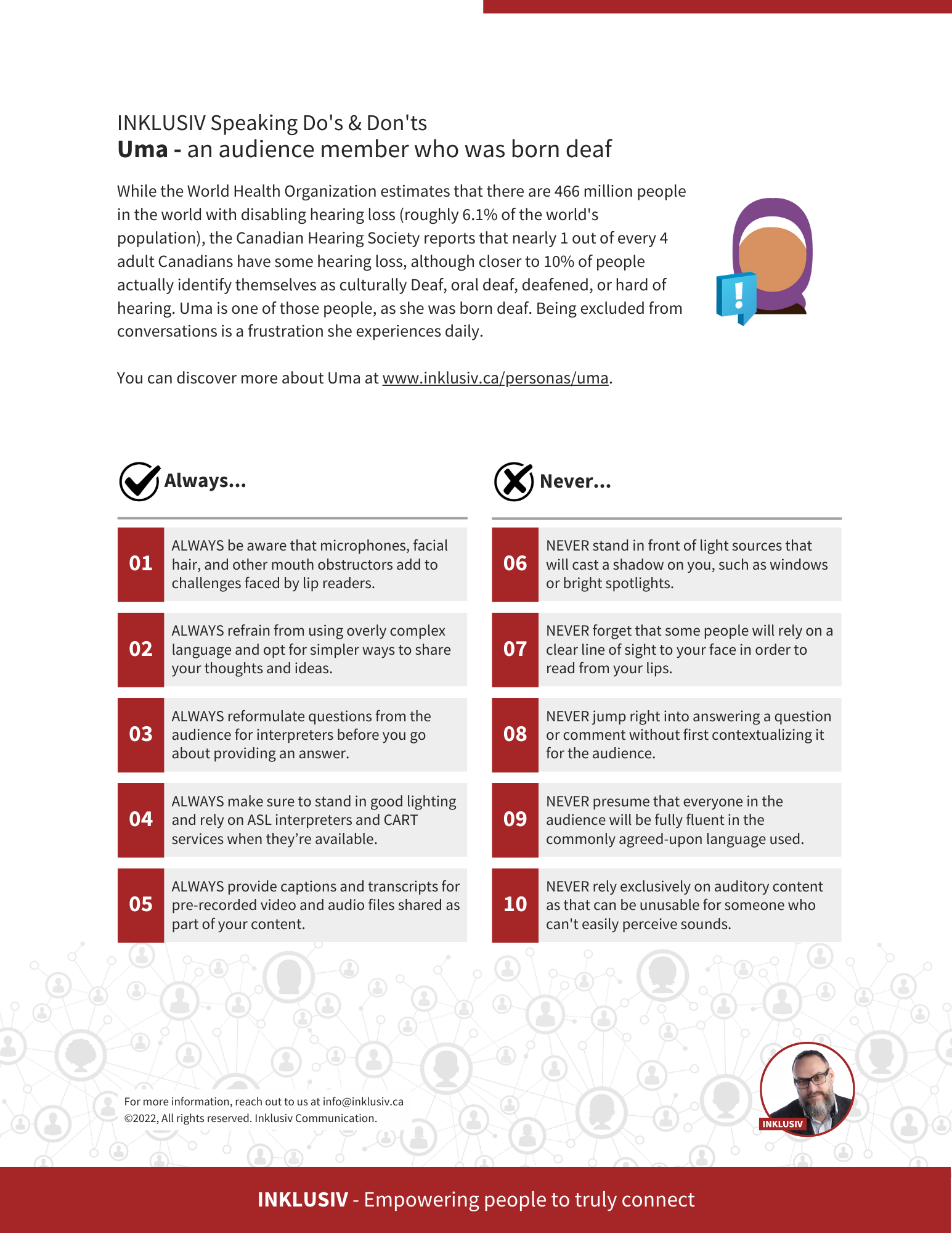Introducing Uma (she/her), an audience member who was born deaf
Like over 360 million people around the world, Uma has disabling hearing loss that came as a result of her inner ears not fully developing during the pregnancy. “As someone who was born deaf, I struggle every day with hearing and interacting with the people around me,” Uma explains. “But I don’t let it slow me down! I am professionally active, I attend conferences, and I take part in meetings”. While she always misses a part of what speakers say, she still feels like she’s getting a lot from those experiences.
“Like most people, I enjoy learning from experts. The opportunity to attend talks is a great way to help with my own professional development. Something vital, when you happen to be Vice-President Marketing for a Fortune 500 company,” she adds with a proud grin on her face.
When it comes to online learning, turning on captions is an absolute must whenever she watches video content. “At conferences or in meetings, I’ve developed a few coping mechanisms, such as arriving early, so I can sit in the front row, or as close as possible to where the speaker will be. Through a combination of lip reading and real-time captioning, I manage to do pretty well… at least according to my own standards.”
But every time a speaker fails to speak into the microphone, or fails to repeat a question from the audience, Uma feels excluded. “Every time a speaker turns their back to the audience, or audio content is provided without transcripts, I miss critical information. Every time a video is played without captions, or someone dims the lights, I become disadvantaged and feel powerless because I can no longer keep track of what is going on”. And unfortunately for her, these things happen a lot.
“Exclusion has a significant impact on my life. It causes feelings of loneliness, isolation, frustration, and powerlessness. Every single day.” As speaking professionals, we can play a meaningful role in preventing someone like Uma from feeling lonely, isolated, frustrated, and powerless. As speakers, would you say it is worth the effort to work against that?

“Dear speakers, please caption the videos you share! It’s really not that complicated. And while you’re at it, can you also plan for CART and ASL interpreters?”
Uma’s Do’s and Don’ts Poster

Inclusive Speaking Do’s & Don’ts – Uma
As speaking professionals, we pride ourselves on mastering the ability to engage our audience and change their lives with our thoughts and ideas. But just how inclusive are you really, when it comes to touching the hearts and minds of audience members like Uma who deal with disabling hearing loss? Below are some of the basic Do’s & Don’ts that speakers should always keep in mind, when communicating their message to audience members who are deaf or hard of hearing, and struggle with perceiving information conveyed through voice or audio only.
As a speaking professional trying to engage someone like Uma, always…
01. Be aware that microphones, facial hair, and other mouth obstructors add to challenges faced by lip readers

Do you systematically keep in mind that microphones, facial hair, and other mouth obstructors add to challenges faced by lip readers? Did you know that in recent research leveraging technologies to improve automated captions of video content through speech or lip reading showed that on average, humans can only reliably capture about 12% of what’s being said in a conversation, compared to almost 50% for algorithms powered through artificial intelligence? There are so many obstacles that can stand in the way of audience members like Uma when trying to hear — or read — the words that are coming out of speakers’ mouths: facial hair, microphones, lighting, etc. It’s important to remember that audience members who depend on lip reading are always at a disadvantage. Doing everything you can to keep your face free of obstructors will go a long way in helping you come across as more audible and intelligible.
02. Refrain from using overly complex language and opt for simpler ways to share your thoughts and ideas

Do you systematically refrain from using overly complex language and opt for simpler ways to share your thoughts and ideas? Research shows that most people who were born deaf, and learned sign language as their first language, tend to struggle with written languages. Not because they can’t read it, but because the structure of written languages is radically different from the structure of sign languages. Uma is no exception. While she did learn English and French as second and third languages in school, the first language she was taught was ASL (American Sign Language). Her inability to hear has impacted her ability to master spoken languages and left her with low literacy skills that cause her to struggle with text. Relying on plain language techniques can go a long way in helping audience members like Uma who may otherwise feel left out.
03. Reformulate questions from the audience for interpreters before you go about providing an answer

Do you systematically reformulate questions from the audience for interpreters before you go about providing an answer? You might already be mindful, as an experienced speaker, to repeat questions coming from the audience before you answer them. Not only does that allow you to better frame your answer, but it also really helps someone like Uma who depends on interpreters to translate the conversations in a format that better supports those who are deaf or hard of hearing. By first framing your answers, you are helping sign language interpreters and captioners better understand the direction in which the conversation is going. You are also maximizing the interpreters’ understanding of what’s going, which, in turn, will also ensure the accuracy of their interpretation. It’s an absolute win-win situation for everyone involved and goes a long way in showing how much you care about a more inclusive outcome.
04. Make sure to stand in good lighting and rely on ASL interpreters and CART services when they’re available

Do you systematically make sure to stand in good lighting and rely on ASL interpreters and CART services when they’re available? Though we don’t always realize it, the act of listening to speakers and hearing what they’re saying doesn’t only depend on someone’s ability to hear the words that are coming out of their mouths! It also has a lot to do with context: how speakers position themselves on stage, whether they face us directly, whether their mouths are obscured by facial hair or microphones, whether their faces are shadowed, whether they turn their backs on us, etc. All those factors impact just how audible speakers end up being to audience members. But it’s even more true when it comes to people like Uma who are deaf! One way to mitigate such challenges is to always stand in good lighting. Doing so will also optimize communication when interpreters are involved.
05. Provide captions and transcripts for pre-recorded video and audio files shared as part of your content

Do you systematically provide captions and transcripts for pre-recorded video and audio files shared as part of your content? We’ve all sat in noisy, crowded public places, like pubs, gyms, or airports, watching muted television screens, while synchronized captions displayed on those screens allowed us to keep up with what was being said. In those times where our ability to hear is challenged, it’s easier to wrap our head around how much of a game-changer captions are, for people like Uma who experience deafness daily. The same is true with text transcripts, whether they apply to video or audio files. If you share a podcast with your audience, and fail to support your audio files with transcripts, how could someone who’s deaf or hard of hearing be able to consume your content? Not to mention that such text versions will do wonders for your SEO (search engine optimization).
As a speaking professional trying to engage someone like Uma, never…
06. Stand in front of light sources that will cast a shadow on you such as windows or bright spotlights

Do you systematically avoid standing in front of light sources that will cast a shadow on you such as windows or bright spotlights? Most audience members, and particularly those who are visual learners, will listen to you with more than just their ears. A significant portion of your message subconsciously comes through with not only just the words you use, but also through body language, facial expressions, mannerisms, pronunciation, or even the way you carry yourself. Audience members like Uma who cannot rely on their ability to hear will largely depend on those other aspects as well. By making sure that you always stand in good lighting, you are maximizing every participant’s ability to get the most out of what you are sharing. Therefore, you should always be cognizant of light sources, and use them to your advantage. Don’t turn your back on the audience and make sure you’re always well lit.
07. Forget that some people will rely on a clear line of sight to your face to read from your lips

Do you systematically avoid forgetting that some people will rely on a clear line of sight to your face to read from your lips? Inclusive speakers are acutely aware that those who are deaf or hard of hearing will depend, among other things, on their ability to read lips to compensate in part for their hearing loss. While lip reading alone will only go so far in terms of helping someone like Uma successfully stay on top of what is being said, it will still play a significant role in getting her the most out of a presentation. Knowing that lip reading is far from being an exact science, the best way for you to support audience members who rely on this mechanism will be to ensure nothing breaks their line of sight with your properly lit face: microphones, hands, or anything else that can obstruct their view and make communication that much harder.
08. Jump right into answering a question or comment without first contextualizing it for the audience

Do you systematically avoid jumping right into answering a question or comment without first contextualizing it for the audience? Have you ever walked in on someone telling a joke, and all you could get was the punch line? If so, you know all too well the feelings of frustration that come with missing out on the global context. The same is true with Q&A sessions at the end of presentations! If you take questions from the audience, whether it’s in a live, in-person setting, or virtually through platforms like Zoom, Teams, or WebEx, it’s best to have a framing strategy. Jumping straight into an answer without rewording the question first will cause folks like Uma to miss out on some valuable information. Plus, reframing the question allows you to clarify your thoughts before you start speaking, a valuable advantage when people are hanging onto your every word!
09. Presume that everyone in the audience will be fully fluent in the commonly agreed-upon language used

Do you systematically avoid presuming that everyone in the audience will be fully fluent in the commonly agreed-upon language used? As speakers, we make a lot of assumptions about our audience. As an example, how often do you wonder how many people in the crowd might only understand or speak English as a second, or even third language? The words you choose, the complexity of the language you use, how you present those words, the speed at which you speak — all those things can make or break the experience of an audience member whose mastery of the commonly agreed upon language is subpar. For audience members like Uma who speak American Sign Language as their first language, fully mastering that commonly agreed upon language can be a challenge. By supporting your spoken content with text, handouts, and other means, you can help them feel more valued.
10. Rely exclusively on auditory content as that can be unusable for someone who can't easily perceive sounds

Do you systematically avoid relying exclusively on auditory content as that can be unusable for someone who can’t easily perceive sounds? One very important aspect of creating truly inclusive experiences for everyone is to always plan for your content to be deliverable in at least two different modalities. As an example, if you’re going to plan for the audience to listen to an audio clip and then get their reaction, also plan for a text transcript of that audio to be readily available should anyone require it. Better yet, instead of letting people know that they can request the alternative format, just normalize its use by default, by making it an integral part of the planned experience! That way, people like Uma won’t have to feel bad about having to single themselves out, and everyone who is more of a visual learner will also appreciate being able to read along.
Did you know?
Findings from the Conference Board of Canada suggest that the share of people with disabilities in the overall Canadian consumer market will rise sharply over the coming years. In 2017, the consumer market for Canadians with physical disabilities made up about $165 billion CAD or 14.3% of the total consumer market in the country. By 2030, this share will reach 21%, with spending rising to $316 billion CAD annually. Is your business even aware of this untapped market?